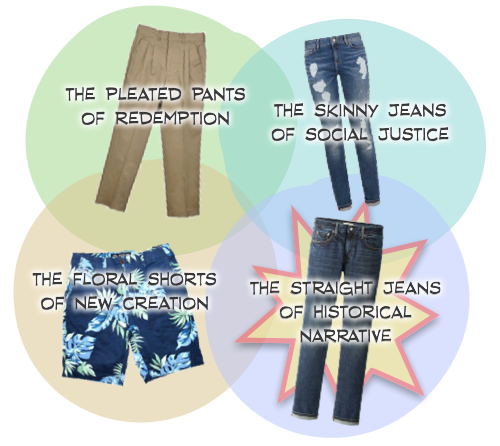I mentioned before the distinction that Scot McKnight makes in his Kingdom Conspiracy book between a “pleated pants” view of kingdom as the redemptive activity of God and a “skinny jeans” view of the kingdom as social activism in which the church may be more of a hindrance than a help.
You probably have to be American really to appreciate the sartorial metonymy, but I think we can usefully extend the classification.
1. We can add a “floral shorts” kingdom paradigm that basically equates the kingdom of God with the renewal of creation. This seems to me to be a popular evangelical-narrative-theology alternative to the “skinny jeans” position for people who want to remain faithful to scripture. See, for example, Marlin Watling’s nifty illustrated guide to Tom Wright.
2. There is the “straight jeans” approach (simply my personal preference in trousers) which attaches the kingdom of God firmly to the historical narrative of God’s people. If I’ve understood him correctly, this is what McKnight is trying to do. My view is that he still blurs the distinction somewhat between the historical narrative and a theologised narrative overlay, but it is a big step in the right direction.

Of course, redemption, social justice, and new creation all have a direct missional relevance. The church can go out and actively save souls, pursue social transformation, or do what it can to retard the melting of the ice caps.
The narrative-historical hermeneutic, on the other hand, is just that—a hermeneutic, a way of reading the New Testament. The mission of the church is not to persuade the world to read the New Testament narrative-historically. Sadly.
But it gives us an opportunity to step back and reassess the relation between scripture and the mission of the church. From that reassessment two outcomes, it seems to me, are worth highlighting here.
1. The “straight jeans” approach compels us to reckon with the concrete existence of the church as a historical people called to serve the creator God. As McKnight puts it, when it comes to Jesus’ kingdom story and kingdom mission, “the kingdom of which Jesus speaks is a people governed by a king” (74, italics removed). He goes on:
An array of shifts will occur when Jesus becomes King over a people, but the word “kingdom” cannot be reduced either to justice or salvation without doing serious damage to the story that animates the word “kingdom.” When Jesus said the kingdom has drawn near, he meant we are about to see a new king governing a new people—that people will be marked by salvation and justice, but it is a people first and foremost.
2. The “straight jeans” approach provides a way of integrating redemption, social justice, new creation, and a lot of other stuff, into a coherent understanding of what the church is about. The whole story tells us what mission is, not just the beginning and the end, or the middle, or odd bits selected according to ideological preference.
So briefly…
God re-establishes his rule over his people in the New Testament story by putting forward Jesus as a propitiation for their sins; and Jesus who was crucified, was made king, to judge and rule over the family of Abraham throughout the coming ages.
God intervenes as King to judge his people not least because they fail to keep the way of the Lord by doing righteousness and justice; and when his people get it right, when they do the right thing, they are a benchmark of righteousness and justice in the world.
The purpose or mission of the church, in the broadest sense, is to serve, or serve the interests of, the living creator God as a new creation people. The kingdom is God throughout history keeping this fragile, sinful priestly-prophetic community on the road, most importantly (in the fulness of time) by giving his Son authority to rule as king.



Recent comments